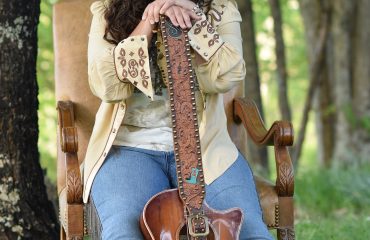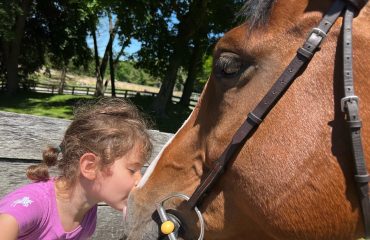
Stephanie with Valentine, a horse owned by a client Photo by Carter Anderson
By Carter Anderson
Have you ever wondered what the judge is looking for? Stephanie Cumming has been judging collegiate meets for eight years and has a specific process when choosing the winner. If she’s not in the judge’s booth, you can find Stephanie running her business, Pecan Lane Farm, based in Bishop, Georgia. Her background in eventing and years of experience in the saddle and training top riders has allowed her to give firsthand understanding when judging at regular horse shows and judging girls at NCAA equestrian meets.
How and when did you start judging collegiate meets?
I started judging collegiate meets about seven years ago. I got my first job judging a University of Georgia equestrian scrimmage. I have known Meghan Boenig, the head coach at the University of Georgia, since we were kids. She knew that I would understand how to judge a flat pattern due to having an event background when I was younger.
What was the first meet you ever judged?
My first real meet job was in the Big 12 at Oklahoma State University. I judge two to three meets per year.
Describe your process when judging a flat pattern.
My process is pretty routine. First, I look over the pattern. Since I’ve always been comfortable with the format, I have my scribe read through the test during the exhibition rides and say “score” at the end of each scored movement. By the second exhibition ride, I usually have a good feel of the test and just ask for the scribe to yell “score” when she needs a score. Usually after the next couple of rides, I know when to score so I’ve gotten into a rhythm. I try very hard to talk as much as I can through each ride to give as much reasoning for my scoring as I can. I know this part of the format can be difficult for some judges.
Describe your process when judging a fences round.
As for the jumping format, this is just like judging at normal USEF shows. I start all rides out with a number in mind and go up or down from there as a trip goes. I judge each jump and the tracks in between. Then, I give an overall score at the end of the trip, keeping in mind that overall equitation will sway my score up or down a bit, too.
 What are the three most important things you look for in good equitation?
What are the three most important things you look for in good equitation?
The three most important things in good equitation for me are: 1) a solid foundation via leg and seat; 2) quiet and educated hands; and finally 3) a rider that can navigate a horse effortlessly, meaning that she rides any type of horse in a manner that I would want her to ride any horse of my own.
What is your biggest pet peeve in regard to a round or a pattern?
My biggest pet peeve is bad hands. I hate rough hands and lack of connection.
Since you began judging, how has college riding evolved?
I believe that this sport has gotten much more competitive. It has gotten tougher and tougher for a young lady to be recruited due to how many good-riding girls there are. I also think that good flatwork has become more and more important to coaches looking to build a competitive team.













